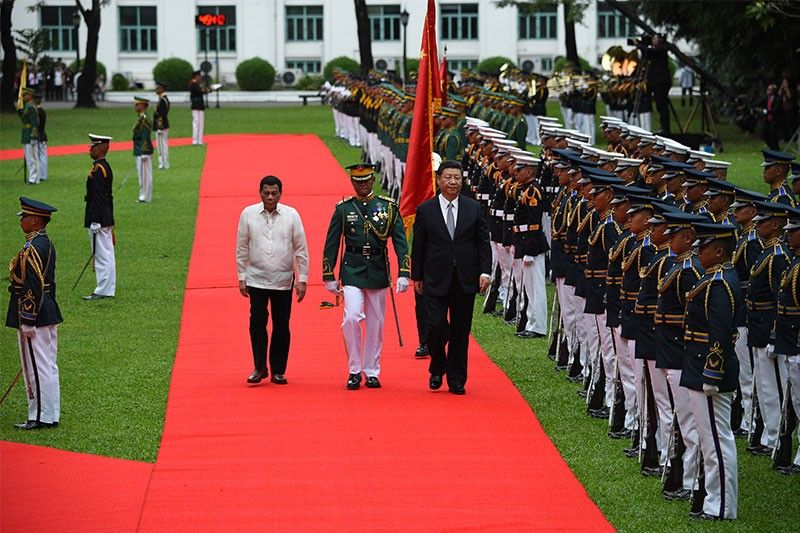Commentary: Is an appeasement policy vis-a-vis expansionist China worth pursuing?

On Aug. 15, 2019, Philippine Defence Secretary Delfin Lorenzana announced the incursion of several Chinese warships into the country’s territorial waters without prior coordination with the Armed Forces of the Philippines (AFP).
He opined that China was taunting the Philippines because the warships’ Automatic Identification System (AIS) was switched off and the Chinese crews ignored the radio communications from the AFP units that were observing their passage in Sibutu Straits in Tawi-Tawi.
He also maintained that the People’s Liberation Army’s Navy (PLAN) reneged on an earlier promise made by the Chinese ambassador in Manila that the Philippines will be informed in advance of any movement of PLAN vessels in the country’s territorial waters.
Consequently, the Defense secretary recommended the filing of a diplomatic protest by the Department of Foreign Affairs following the series of suspicious and unauthorized transits of Chinese warships in Philippine waters including the passage of two Chinese survey ships in the country’s exclusive economic zone (EEZ).
President Rodrigo Duterte, however, emphasized the futility of confronting China as he opted for regularly scheduled bilateral consultations between the two countries conducted in an avowedly friendly atmosphere.
These divergent positions emanating from Duterte, and the AFP, and the DND reflect an ongoing internal debate within the administration.
This discord is between two groups of government officials who want to balance China’s growing naval power in the South China Sea on the one hand, and those who believe that the path of peacefully resolving the territorial row is through diplomacy and economic cooperation on the other hand.
One group urges the government to challenge China’s growing naval presence in the South China Sea. The other group wants to continue the administration’s appeasement policy on China.
This clash within the government incrementally pushed the Duterte administration to adopt a policy of soft balancing on China.
China’s broken promises
At the beginning of his term in mid-2016, Duterte was determined to take advantage of China’s economic largesse under its Belt and Road Initiative (BRI). Lured by the BRI, Duterte actively sought Chinese financial assistance for the construction of drug-rehabilitation centres for Filipino drug addicts and soft loans for the building of railways and roads in Mindanao and in other parts of the country.
The Philippines sought Chinese investments in the reclamation of the Davao coastline, seaport and bulk terminal construction projects in cities such as Davao, Cebu, and Manila, and the building of highways and railways amounting to US$9 billion.
In May 2017, Duterte went to Beijing in person to follow up his initial negotiation with President Xi Jinping in October 2016. The Philippine ambassador to Beijing, however, admitted that “there were several discussions between the countries regarding these BRI projects, but they remained discussions way into 2019.”
Ongoing BRI projects in the Philippines include the constructions of two bridges in Manila and a projected larger South Long-Haul Railway that will connect ports and special economic zones in the main island of Luzon.
However, there is no single major port development project that “would have been more in line with the BRI’s thrust of increasing regional connectivity and allow the Philippines to be linked to the Maritime Silk Road.”
The absence of such projects limits the Philippines from having closer trade linkages with Asia and Europe.
The Nomura Research Institute reported that “most of the big-ticket multi-year projects (under the BRI) in the pipeline are still under consideration and may, therefore, be susceptible to the risk of another pivot when a new (Philippine) president takes over in 2022.”
The shortfall on expected Chinese public investment to the country coincided with a series of incidents between Philippine and Chinese forces in the South China Sea.
In mid- June 2018, then Philippine Foreign Affairs Secretary Alan Peter Cayetano disclosed that the Philippines informed China of the four “red lines” in the two countries’ territorial disputes.
In the same month, the Philippine government issued a formal demand that China’s Coast Guard steer clear of the Philippines’ traditional fishing grounds around the Scarborough Shoal and stop the harassment of Filipino fishermen around the shoal.
This was triggered by TV news that Chinese coast guard personnel are boarding Filipino fishing vessels, inspecting the fish caught, and confiscating the fishermen’s best catch.
Shifting from appeasement to soft balancing?
Evidently, the Duterte dministration was convinced that its appeasement policy on China was worth pursuing because it would make the Philippines a beneficiary of the former’s emergence as a global economic power.
However, China has not reciprocated the Philippine’s appeasement policy as it has delayed the funding of various infrastructure projects under the Duterte administration’s “Build, Build, Build” program.
PLA units have also continued their coercive actions against Philippine military aircraft and ships operating in the South China Sea.
The Duterte administration has slowly and reluctantly adopted a policy of soft balancing. It pursues soft balancing by: a) fostering its security partnership with Japan; b) maintaining its alliance with the U.S.; and c) pushing for the immediate passage of the ASEAN-China code of conduct.
In 2016, the Duterte administration’s goal was to promote closer Philippine-China economic diplomatic relations that could moderate Chinese coercive behaviour in the South China Sea.
Three years after experimenting with an appeasement policy, the Philippine government’s objective vis-à-vis China has changed.
The goal now is to restrain Chinese aggressive behaviour in the South China Sea through the country’s alliance with the US, its security partnership with Japan, and a more active participation in the ASEAN.
The Duterte administration hopes that these measures can stop or constrain China’s heavy-handed behaviour vis-à-vis the Philippines relative to the South China Sea dispute.
Renato Cruz de Castro is trustee and convenor of the National Security and East Asian Affairs Program of think tank Stratbase ADR Institute.
- Latest



























